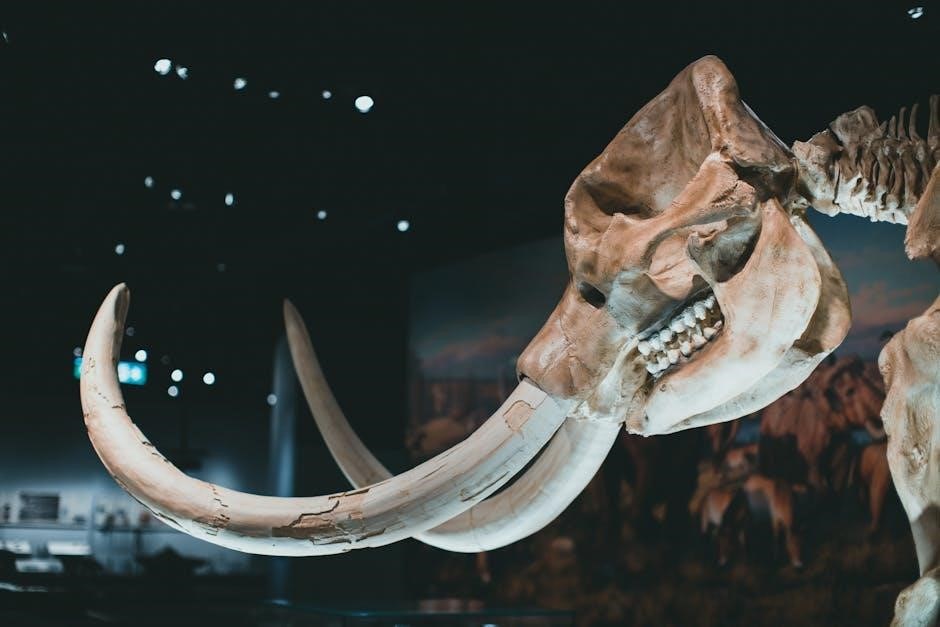This guide provides a comprehensive overview of U.S. History, designed to help students prepare for the End-of-Course exam. It covers key events, figures, and themes, offering strategies for effective study and success.
Understanding the Purpose and Structure of the EOC Exam
The American History EOC exam evaluates students’ knowledge of significant events, figures, and movements that shaped the U.S. It assesses analytical skills, requiring connections between historical themes rather than mere memorization. The exam includes selected-response questions and may feature other formats to test comprehension. Understanding the structure helps students focus on key concepts and prepare effectively for the assessment, ensuring readiness to demonstrate their grasp of U.S. History.
How to Use This Study Guide Effectively
To maximize the effectiveness of this study guide, students should review its content systematically. Begin by identifying key themes and concepts, then use the provided flashcards and practice questions to reinforce understanding. Regular review sessions and active engagement with the material are crucial. Additionally, integrating the guide with classroom notes and textbook readings will enhance retention. Prioritize understanding over memorization, and utilize online resources for supplementary practice, ensuring a well-rounded preparation for the EOC exam.

Exploration and Colonization (Pre-Columbian Era – 1776)
European exploration of the Americas was driven by economic, religious, and territorial ambitions. Key events include the Treaty of Tordesillas, early settlements, and interactions with Native Americans, shaping colonial foundations.
Reasons for European Colonization of the Americas
European colonization of the Americas was driven by economic motives, such as the quest for gold, resources, and new trade routes. Religious and political factors also played a role, with nations seeking to spread Christianity and establish strategic territories. Additionally, population growth and social unrest in Europe pushed many to seek better opportunities across the Atlantic. These diverse motivations laid the foundation for the complex dynamics of colonization.
Key Figures and Events: Explorers, Native Americans, and Early Settlements
Explorers like Christopher Columbus and Vasco Núñez de Balboa opened the Americas to European influence. Native Americans faced profound changes as their lands were settled. Early settlements, such as Jamestown and Plymouth, struggled initially but eventually thrived. These events set the stage for the cultural and political development of the region, shaping the interactions between indigenous peoples and European settlers.
The Impact of Colonization on Indigenous Populations

Colonization brought devastating consequences for Native Americans, including the spread of diseases, loss of land, and cultural destruction. European settlers often displaced indigenous populations, leading to forced relocation and violence. The introduction of new illnesses, to which Native Americans had no immunity, caused significant population decline. Additionally, the disruption of traditional ways of life and the imposition of European norms eroded the cultural and social fabric of indigenous communities, leaving lasting scars that persisted for generations.

The American Revolution and the Birth of a Nation (1776–1789)
The American Revolution marked the colonies’ fight for independence from Britain, culminating in the Declaration of Independence in 1776. This period saw the emergence of the United States as a sovereign nation, shaped by the ideals of liberty and democracy, and laid the foundation for the Constitution and the Bill of Rights, defining the framework of American governance.
Causes and Key Events of the American Revolution
The American Revolution was sparked by colonial resistance to British taxation without representation, such as the Stamp Act and Tea Act. Tensions escalated with the Boston Massacre and Boston Tea Party. The Declaration of Independence, authored by Thomas Jefferson, affirmed the colonies’ sovereignty in 1776. Key battles like Lexington and Concord, Bunker Hill, and Saratoga marked the war’s progression. The Treaty of Paris in 1783 ended the conflict, recognizing the United States as an independent nation.
The Declaration of Independence and Its Significance
The Declaration of Independence, authored by Thomas Jefferson, was adopted on July 4, 1776. It formally declared the 13 colonies’ independence from Great Britain, establishing the United States as a sovereign nation. The document outlined the colonies’ grievances against King George III and affirmed the principles of liberty, equality, and consent of the governed.
Its significance lies in its foundational role in American democracy, influencing global movements for independence and human rights. It remains a cornerstone of U.S. history and identity, shaping the nation’s political philosophy and ideals.

The Civil War and Reconstruction (1861–1877)
The Civil War was fought between the Union (Northern states) and Confederacy (Southern states) over issues like slavery and states’ rights. The Emancipation Proclamation and 13th Amendment ended slavery, reshaping the nation’s future during Reconstruction.
Causes and Major Battles of the Civil War
The Civil War (1861–1865) was driven by deep divisions over slavery, states’ rights, and economic and cultural differences between the North and South. Key battles included Fort Sumter, the first engagement; Bull Run, which showed the war’s severity; Antietam, leading to the Emancipation Proclamation; Gettysburg, a turning point; and Vicksburg, securing the Mississippi River for the Union. These battles were pivotal in shaping the war’s outcome and ultimately led to the Union’s victory and the abolition of slavery.
The Emancipation Proclamation and the 13th Amendment
Issued by President Abraham Lincoln in 1863, the Emancipation Proclamation declared freedom for enslaved individuals in Confederate states. Though it didn’t immediately free all slaves, it paved the way for abolition. The 13th Amendment, ratified in 1865, permanently ended slavery across the United States. Together, these landmarks redefined freedom and equality, reshaping the nation’s future and fulfilling the promise of liberty for all Americans.

Industrialization and Urbanization (1877–1914)
The late 19th and early 20th centuries saw rapid industrialization and urbanization, driven by technological advancements and mass production, transforming the U.S. economy and society.

The Rise of Industrialization and Its Economic Impact
Industrialization transformed the U.S. economy, shifting from agrarian to factory-based production. Technological innovations, like the assembly line, boosted efficiency. Corporations dominated industries such as steel and oil, led by figures like Rockefeller and Carnegie. Mass production lowered costs, increasing consumer goods availability. Urbanization grew as workers moved to cities for jobs. This era saw significant GDP growth, job creation, and the rise of industrial capitalism, reshaping the nation’s economic landscape and fostering modernization, despite challenges like labor exploitation and inequality.
Key Inventors and Innovations: Thomas Edison, Alexander Graham Bell
Thomas Edison, a prolific inventor, revolutionized daily life with the electric light bulb, phonograph, and motion pictures. His innovations in electrical systems laid the groundwork for modern technology. Alexander Graham Bell patented the telephone, transforming global communication. Both inventors exemplified the spirit of industrialization, driving technological progress and shaping the 19th and early 20th centuries. Their contributions remain foundational to contemporary advancements in communication and energy, highlighting their enduring impact on society.

World War I and the Roaring Twenties (1914–1929)
This transformative period saw the end of World War I, cultural shifts, and economic prosperity. The Harlem Renaissance flourished, marking a pivotal era of social change and innovation.
American Involvement in World War I
The U.S. initially maintained neutrality in World War I, focusing on domestic affairs and economic interests. However, Germany’s resumption of unrestricted submarine warfare and the Zimmermann Telegram led to America’s entry in 1917. The war marked a turning point, as the U.S. emerged as a global power. The Treaty of Versailles, though divisive, showcased America’s influence, particularly through Wilson’s 14 Points, which aimed to establish a new international order and prevent future conflicts.
The Harlem Renaissance and Social Change
The Harlem Renaissance (1918–1937) was a cultural and intellectual movement centered in Harlem, New York, celebrating African American identity. It emphasized racial pride and challenged stereotypes through art, literature, and music. Figures like Langston Hughes, Zora Neale Hurston, and Duke Ellington gained prominence. The movement fostered social change by promoting equality and inspiring later civil rights efforts, leaving a lasting legacy on American culture and social justice.

The Great Depression and the New Deal (1929–1941)
The Great Depression caused widespread economic hardship, prompting Franklin D. Roosevelt’s New Deal, which introduced reforms and programs to stabilize the economy and provide relief to Americans.
Causes and Effects of the Great Depression
- The 1929 stock market crash triggered widespread economic collapse.
- Banks failed, leading to massive losses of savings.
- Unemployment soared, leaving millions without income.
- Consumer spending declined, halting industrial production.
- Global trade plummeted, exacerbating economic hardship.
- Farmers faced ruin due to falling crop prices.
FDR’s New Deal Programs and Their Impact
FDR’s New Deal aimed to alleviate the Great Depression through various programs. The Civilian Conservation Corps (CCC) provided jobs in conservation, while the Works Progress Administration (WPA) funded public projects and arts. The Social Security Act established a safety net for the elderly and unemployed. These programs revitalized the economy, restored hope, and reshaped the role of government in addressing societal challenges, leaving a lasting legacy in American history and policy;

World War II and the Cold War (1941–1991)
American leadership in World War II and the subsequent Cold War shaped global dynamics. The U.S. emerged as a superpower, influencing international relations and domestic policies during this transformative era.
American Leadership in World War II
American leadership played a pivotal role in World War II, with President Franklin D. Roosevelt and General Dwight D. Eisenhower guiding the nation’s strategy. The U.S. contributed significantly to the Allied victory, particularly through initiatives like the Lend-Lease Act and decisive battles such as D-Day. American innovation and industrial might bolstered the war effort, leading to the defeat of Axis powers. This era solidified the U.S. as a global superpower and set the stage for its leadership in the ensuing Cold War.
The Civil Rights Movement: Key Events and Legislation
The Civil Rights Movement sought to end racial segregation and discrimination through landmark events like Brown v. Board of Education, the Montgomery Bus Boycott, and the March on Washington. Legislation such as the Civil Rights Act of 1964 and the Voting Rights Act of 1965 were pivotal, ensuring equal rights and voting protections. Leaders like Martin Luther King Jr. and Rosa Parks played crucial roles in advancing equality and justice, shaping a more inclusive American society.
Mastering U.S. History requires consistent review and strategic planning. Utilize flashcards, practice exams, and study groups to reinforce key concepts and ensure exam readiness.
Strategies for Success on the EOC Exam
To excel on the EOC exam, focus on understanding key themes and concepts rather than memorizing dates. Use active study techniques like flashcards and practice tests to reinforce learning. Review past exams to familiarize yourself with the format and question types. Allocate time evenly across all sections and avoid spending too long on a single question. Stay calm and manage your time wisely to ensure you complete the test confidently.
Recommended Resources for Additional Study
Enhance your preparation with online platforms like Khan Academy and Quizlet for interactive lessons and flashcards. Utilize practice tests from official EOC websites to familiarize yourself with exam formats. Supplement your textbook with resources like “A People’s History of the United States” for diverse perspectives. Visit the National Archives and Library of Congress websites for primary sources. Join online forums or study groups for collaborative learning and discussion.